Banff Springs snail (Physella johnsoni) COSEWIC assessment and status report: chapter 7
Habitat
Canadian thermal springs are confined to the mountainous areas of the Cordilleran regions of Alberta, British Columbia, Yukon, and the Northwest Territories (Van Everdingen 1991). They are fragile, and small-scale ecosystems with rare micro-climatic conditions created by and wholly dependent on local geothermal activity and can be considered harsh environments with high temperatures, high concentrations of dissolved minerals, and low levels of dissolved oxygen (Brues 1924, 1927). With the exception of the Vermilion Cool Springs, the Sulphur Mountain thermal springs occur along the Sulphur Mountain thrust fault on an elevational gradient from the Upper Hot to the Cave and Basin (Figure 5). The Vermilion Cool Springs occur along the Bourgeau thrust (Grasby and Lepitzki 2002). Water in the form of rain and snow falling on neighbouring Mount Rundle is believed to be the source for the Sulphur Mountain thermal springs (Grasby and Lepitzki 2002). This meteorological water circulates to a depth of approximately 3.2 km; heat and dissolved minerals are added to the water from the surrounding rock (Grasby and Lepitzki 2002). In general, the highest elevation springs are the hottest (Upper Hot) with maximum temperature declining along the elevation gradient (Figure 6). Seasonal changes occur in water physicochemistry with the magnitude of the change generally largest at the highest elevation springs. The springs reach their maximum temperature during the winter (Figure 7) when infiltration from melting snow and ice is reduced. During spring run-off, additional shallow ground water results in increased flow rate, pH and dissolved oxygen levels and decreased water temperature, conductivity and hydrogen sulphide levels (Figure 8). The seasonal changes in water physicochemistry result in seasonal changes in the microbial community inhabiting the springs (Van Everdingen 1970; Grasby and Lepitzki 2002).
Figure 6: Water physicochemistry in the origins of the thermal springs historically inhabited by Physella johnsoni
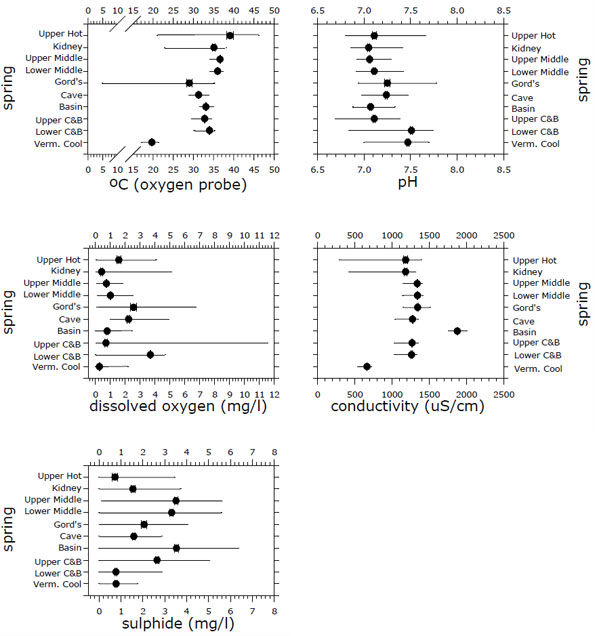
Means, standard errors of the mean, and range of parameters measured from March 1998 through December 2005 by a hand-held multimeter and portable spectrophotometer (sulphide) during snail surveys are shown; measurements in Gord’s Pool Spring began in January 2001. Large ranges result from springs drying and/or seasonal fluctuations.
Figure 7: Water temperature at Kidney Spring origin measured hourly by automatic temperature loggers (solid line) and during snail surveys (dots), May 1998 through 9 September 2006
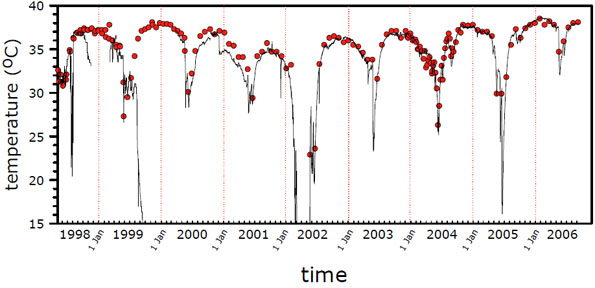
The dips in the logger traces in 1998 and 1999 are erroneous, the first dip in 1998 is the result of the logger being removed from the water and the others are due to malfunctions. The dip early in 2002 is the result of the spring drying.
Figure 8: Water physicochemistry of Kidney Spring origin measured with a hand-held multimeter and portable spectrophotometer (sulphide), March 1998 through December 2005
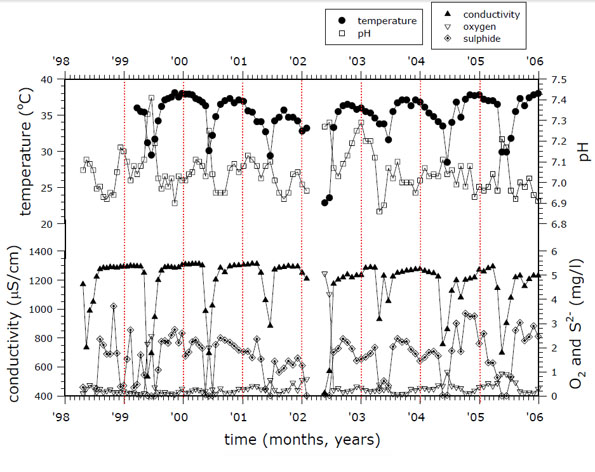
Lack of measurements early in 2002 result from the spring drying.
Spatial changes also occur along the course of the thermal spring from the origin pool down the outflow stream in both the microbial community (Lepitzki pers. obs.; Londry 2005a, b) and water physicochemistry-water temperature and sulphide decline, while pH and dissolved oxygen increase (Lepitzki 2002a; Londry 2005a, b). These biotic and abiotic gradients may explain the microdistribution of the snail whereby most of the snails for most of the year are found at or near the origin pools of the various springs (Figure 9). As such, the Banff Springs Snail is considered a thermal spring habitat specialist dependent on a steady supply of warm thermal spring water containing a high concentration of dissolved minerals, noticeably high levels of hydrogen sulphide and a complex microbial community that provides food and habitat structure. Most of the snails are found at the air-water interface, clinging to floating mats of algae, bacteria, woody debris and leaves or on the edges of emergent rocks, concrete and rubber pool liners, and the riparian margin. While the upper reaches and origin pools of the thermal spring are the preferred, natural habitat for the species, the P. johnsoni has been successfully maintained in natural thermal spring water in flow-through aquaria with and without the addition of fish food flakes and also in warmed tap-water where the snails fed on fish food flakes (Lepitzki 2003a,b, 2004; see Adaptability).
Figure 9: Microdistribution of Physella johnsoni at the Upper C&B Spring, 1996 through 2001
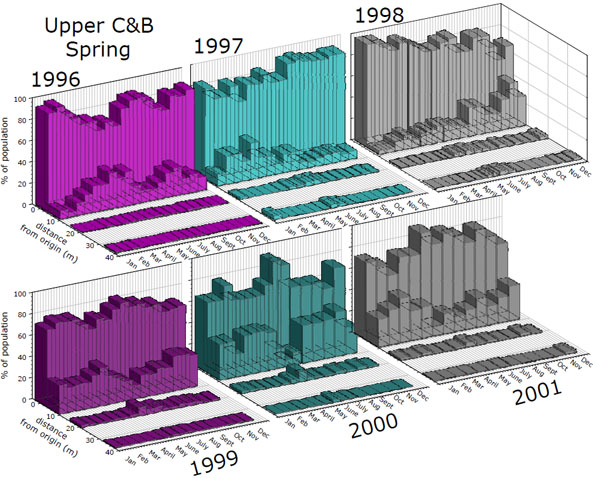
Snails were counted in four microsites from the origin pool and down the outflow stream.
Because the species is limited to thermal springs, the habitat is naturally fragmented and patchy with only the upper reaches being preferred. In general, diversity of other thermal spring dependent flora and fauna increases with distance from the thermal spring origin pool. Recent survey work has identified two rare damselflies (Rice 2002; Acorn 2004; Hornung 2005; Hornung and Pacas 2006), and a number of rare mosses and liverworts (Krieger 2003). There is also a high diversity of algae (26 genera, representing between 40 and 50 species; Hebben 2003), and novel strains of bacteria, many of which are potentially endemic to the Banff thermal springs (Yurkov and Bilyj 2005). At least two vascular plants (hot springs millet Panicum acuminatum; bracken fern Pteridium aquilinum) appear to have been extirpated, both having last been seen at the C&BNHS in 1899 (Wallis 2002). A fish subspecies (Banff Longnose Dace Rhinichthys cataractae smithi), endemic to the springs at the C&BNHS, is extinct (COSEWIC 2006).
The Banff Springs Snail has a certain tolerance for natural disturbance and is able to survive the natural seasonal fluctuations in water flow and physicochemistry and the natural cycles in the microbial community. The species has been able to withstand redevelopment at the C&BNHS (see Habitat Trends); however, in the 70 years since the species has been known to science, at least half of the historical sites have been extirpated even though all were within a national park.
Water physicochemistry of some of the Sulphur Mountain thermal springs was measured as early as 1916 and 1917 (Satterly and Elworthy 1917; Elworthy 1918). The temperatures recorded near the turn of the last century fall within the ranges of the more recent measurements. In general, temperature and chemistry of individual springs are constant through time (Grasby et al. 2000) although in a geological context, spring extinction also occurs. Brues (1928) found evidence of the vast extent and enormous size of earlier springs, now extinct, in areas still containing springs. Even within the Middle Springs area, there is evidence of at least one spring having permanently ceased flowing, possibly centuries ago (Lepitzki pers. obs.). The large tufa boulders near the current origin of the Upper C&B are evidence of a collapsed cave (Grasby et al. 2003). In addition, the extensive tufa mound at the Upper Hot may suggest that overall flow was greater or more dispersed than it is today although piping and impoundment of water sources has also contributed to the prolific vegetation growth on the mound (Grasby and Lepitzki 2002).
While it is normal for flow rates to decrease as underground reservoirs are depleted of water during late winter and early spring (Van Everdingen 1970, 1972; Grasby and Lepitzki 2002), the frequency of thermal spring drying has increased. The only historically recorded instance of any Sulphur Mountain thermal spring drying is the Upper Hot, when no water flowed from 12 March through 11 May 1923 (Elworthy 1926; Warren 1927). Since 1996, the Upper Hot Spring dried during eight winters (Figure 10) with the flow stoppage ranging from approximately one to 32 weeks in duration (Grasby and Lepitzki 2002, Lepitzki unpubl. data). A lower than normal amount of precipitation in 1922 was the proposed cause of the 1923 flow stoppage (Warren 1927). Similarly, below normal precipitation may be the cause of the recent flow anomalies (Grasby and Lepitzki 2002). The lowest precipitation year on record (2001) (Grasby and Lepitzki 2002) was followed by the most extensive period of drying at the Upper Hot, and, for the first known instance, the drying of Kidney Spring (Lepitzki and Pacas 2003). While it is expected that the topographically highest springs along the Sulphur thrust fault will stop flowing first (Grasby and Lepitzki 2002), inexplicably, the Upper Middle Springs dried for at least 12 weeks during the winter of 1995-1996 (Grasby and Lepitzki 2002) and Gord’s Pool Spring dried during the fall and winter of 2005-2006 and 2006-2007 when all other Sulphur Mountain thermal springs continued to flow (Figure 10).
Figure 10: Timing and duration of thermal spring flow stoppages, 1 January 1996 through 31 December 2006, Banff National Park
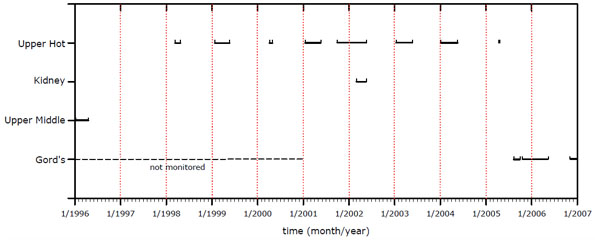
The only previously known instance of any Sulphur Mountain thermal spring drying was the Upper Hot which dried from 12 March to 11 May 1923. The line between the uprights indicates when no thermal spring water flowed as shown by observation and temperature logger data. Monitoring of Gord’s did not begin until January 2001.
Climate change projections for BNP predict a decrease in summer precipitation and an increase in winter and spring precipitation (Scott and Suffling 2000; Scott and Jones 2005). Consequently, water flow of Sulphur Mountain thermal springs is expected to remain near current levels or decrease slightly (Scott and Suffling 2000). If the past 10 years are any indication of the future under the climate change predictions, continued flow anomalies, including cessations, are expected.
All thermal springs historically or currently occupied by the Banff Springs Snail have been impacted by human development, although some have returned to a more natural state. The Upper Hot Spring is the source for the only remaining thermal spring public bathing facility in BNP and has been continually used as such since at least 1918 (Van Everdingen 1972). Nearly 300 000 people bathed at the Upper Hot in fiscal year 1995/1996 (Davidson pers. comm. 1996); current numbers are suspected to be similar. Originally, several spring outlets formed the large tufa mound at the Upper Hot but in the late 1800s water was collected and piped into an underground concrete cistern (Grasby and Lepitzki 2002). Only when excess water collects in the cistern or it is too cool to be used in the bathing pool, is water allowed to flow on the surface above Mountain Avenue before joining used, chlorinated, pool water and surfacing once again below Mountain Avenue into the outflow stream. The outflow stream eventually empties into the Spray River (Figure 5). Extensive renovations and redevelopment of the main bathing building and pool occurred in 1996. Trails between the Upper Hot and the Sulphur Mountain gondola parking lot also were formalized and a wooden, horizontal pole fence and boardwalk constructed above the outflow stream above Mountain Avenue. Visitors are encouraged to touch the natural thermal water by a cut-out section in the fence on their walk to the bathing pool.
The Kidney Spring, approximately 200 m north of the Upper Hot (Figure 5), was impounded into a small concrete cistern (~0.87 m x 0.87 m) and piped to the Banff Springs Hotel for use in a swimming pool before 1927 (Van Everdingen 1972). It is uncertain when this activity ceased but rusting pipes are still found on site and along the pipeline to the Banff Springs Hotel. Within the past 10 years, the origin of the spring, at a cliff face, was excavated by unknown persons allowing water to flow into the small concrete cistern on the surface as well as through a small underground pipe. The concrete cistern was a favourite place to soak and is still listed as such in a recent guide to the hot springs of western Canada (Woodsworth 1999). Soaking is currently an illegal activity at Kidney Spring, and in anticipation of snail re-introduction the area immediately surrounding the Kidney Spring was fenced in November 2001. The level of habitat disturbance by humans observed during regular snail surveys declined significantly (P<0.05) following the habitat protection actions (Lepitzki and Pacas 2002, 2003). A v-notch weir pipe insert was also placed into the pipe flowing into the concrete cistern in April 2002, when the spring was dry, to permit more accurate measurement of flow rate (Lepitzki et al. 2002a; Hayashi 2004; Schmidt 2005).
The Middle Springs may be the least developed of the Sulphur Mountain thermal springs and are largely in their natural state (Van Everdingen 1972) although they too have been impacted. A commonly held belief suggests that water from the Middle Springs served Dr. Brett’s Sanatorium (built between 1886 and 1888) on the site of the present day Park Administration Building (Van Everdingen 1972). According to Elworthy (1926), the Middle Springs were still in their natural state as of August 1923. Marsh (1974) suggests that water used in the Sanatorium and Dr. Brett’sLithia Water was more likely drawn from below Middle Springs. Water from Middle Springs was impounded and piped into the fish hatchery in the early 1940s (Marsh 1974). Although the impoundment and scheme was soon abandoned, the stream course and volume did not return to their previous states (Marsh 1974). At one time, water from Middle Springs was also piped to the C&BNHS (Parks Canada 1958). Remnants of pipes and pieces of concrete are found scattered in the Middle Springs area, mostly near the spring origins.
The entire Middle Springs area was designated an Environmentally Sensitive Site (ESS) in 1988 (Environment Canada 1988) and is presently within the Sulphur Mountain wildlife corridor (Parks Canada 1997). The ESS designation recognized that “the upper and lower springs remain the only hot springs on Sulphur Mountain left relatively undisturbed; the warm mineral waters created habitat for rare plants and invertebrates; and that the Parks Service would move to acquire the Middle Springs property and revert it to a natural state” (Environment Canada 1988).
The Middle Springs area in the vicinity of the Upper Middle Spring caves was closed to the public in the summer of 1995 as a result of human fecal pollution (Pacas et al. 1996). In June 1997, the Middle Springs area was closed by a Park Superintendent’s order “to protect the threatened Banff Springs Snail from disturbance by humans”. Even though public access to the Sulphur Mountain wildlife corridor was restricted beginning in November 1997, illegal human use of the thermal springs continued. As at Kidney Spring, the level of human disturbance did not decline significantly until additional measures were implemented early in 2002, in anticipation of snail re-introductions (Lepitzki and Pacas 2001, 2002, 2003). V-notch weirs also were installed in the outflow streams of both Upper and Lower Middle Springs in July 2002.
The most famous thermal spring complex in BNP is the C&BNHS whose development history began with the “discovery” of the Cave in 1883 (Parks Canada 1998). This, the “birthplace of Canada’s national parks” system (Parks Canada 1998), has been developed (Van Everdingen 1972) and re-developed:
“The natural conditions in the area have been modified irrevocably by the construction of the existing facilities. Uncontrolled discharge of spring water can no longer be allowed because of the likelihood that this would lead to damage to the facilities. It is thus impossible to return the area to its natural state. All that one can hope is the creation of the quasi-natural conditions that allow capture and full control of the spring discharge” (Van Everdingen and Banner 1982).
More recently, Grasby and Bednarski (2002) lend support to this conclusion stating: “In order to preserve this site, for historic and ecological reasons, the site must be put into an artificial state of suspended animation”. The natural evolution of the cave will be collapse (Grasby et al. 2003) but will never be allowed to occur due to Commemorative Integrity concerns (see Habitat Protection/Ownership).
The last major re-development at the C&BNHS occurred in anticipation of the Parks Canada centennial in 1985. A series of boardwalks leading to thermal spring origins and over outflow streams was constructed; a new rubber, lined impoundment, Billy’s Pool, was made at the Lower C&B Spring; and the Basin Pool was reconstructed. Currently, thermal water is completely confined to constructed pools and outflow streams after surfacing. Outflow is controlled by a series of drains, pipes, and valves before flowing into the Cave and Basin marsh, a Zone 1 Special Preservation Area (Parks Canada 1997). Nearly 165 000 people visited the C&BNHS in fiscal year 1998/1999 (Parks Canada unpubl. data) although visitor numbers have recently dropped to around 100 000 (Parks Canada 2006).
Within the past 10 years (Lepitzki et al. 2002b; Lepitzki and Pacas 2007), improvements have been made to the quality of habitat at the C&BNHS through enhanced habitat protection. Swimming in the Basin and Cave pools has been stopped; additional signs, new swing gates, and pickets on boardwalk railings have been installed at several sites; electronic surveillance, motion detecting spot lights, and audio alarms have been installed at some other key sites. A Park Superintendent’s Restricted Activity Order was implemented in 2002 for all the springs and outflow streams at the C&BNHS and at Kidney Spring. While this order prohibits entry and the handling or disturbing of any organic material and/or aquatic wildlife within the closed areas, full compliance is still lacking (Lepitzki unpubl. data; Parks Canada unpubl. data). As at other springs, a v-notch weir was installed at the Basin outflow stream in November 2005 in an attempt to enhance habitat before the addition of captive-bred snails and to permit a more accurate measurement of water flow (Lepitzki 2005).
The final, apparent, historic site for P. johnsoni is the Cool Springs at Third Vermilion Lake (Figure 5). Although the natural course of the cool springs was destroyed by the construction of the Trans Canada Highway in the 1950s (Holroyd and Van Tighem 1983), the warm waters continue to keep an area of Third Lake ice free during the winter. In November 2005, one of the several thermal spring origins dried but resurfaced on the opposite side of Vermilion Lakes road (Figure 5), additional evidence of the dynamic nature of thermal spring ecosystems.
While the causes and timing of the P. johnsoniextirpations at Upper Hot, Kidney, Upper Middle, and Gord’s Springs since 1926 will never be known, is it tempting to relate them to thermal spring drying. A thermal spring drying event can be considered a short-term loss of habitat or a severe decrease in habitat quality but only if the water flow returns. The probability of snails surviving the drying episode would be dependent on the time of year and duration. All the extirpated subpopulations inhabited thermal springs that have dried since 1996 for periods ranging from one week to over half a year (Figure 10). With the exception of the Upper Hot, none was historically known to have ceased flowing prior to 1996. Because it is unknown exactly where and when snails were historically collected at the Upper Hot and whether they were empty shells or contained live animals, the 1923 drying cannot be definitely shown as the cause of the Upper Hot extirpation. Similarly, whether earlier, unrecorded drying events contributed to other subpopulation extirpations is uncertain. Normal, seasonal flow reductions coupled with water impoundment and piping could also have contributed to extirpations.
All habitat for the Banff Springs Snail is located on federal land in Banff National Park, so enough habitat should be protected to ensure long-term survival of the species. However, four of the five natural subpopulations are found within the Cave and Basin National Historic Site, a high visitor-use area, where maintenance of ecological integrity (EI) (Canadian Heritage 1994) is not the only guiding principle. Ecological integrity is defined as “a condition where the structure and function of an ecosystem are unimpaired by stresses induced by human activity and are likely to persist” (Canadian Heritage 1994). The C&BNHS became a national historic site in 1985 (Parks Canada 1998) and while it is located within BNP and is subject to the National Parksand the Species at Risk acts and Regulations, it is also managed (Lepitzki and Pacas 2007) to preserve its commemorative integrity (CI) in accordance with the site’s management plan (Parks Canada 2006) and commemorative integrity statement (Parks Canada 1998). Commemorative integrity means protect, present, and manage cultural resources (Lepitzki and Pacas 2007). Within the past 10 years, conflicts have arisen at the C&BNHS in trying to attain both EI and CI. The Recovery Strategy and Action Plan (Lepitzki and Pacas 2007) states that “the juxtaposition of the snail’s thermal spring habitat within BNP and the C&BNHS requires that recovery can only be achieved if both Ecological and Commemorative Integrity are fully integrated.” It also states that “a key challenge” is protecting and restoring snail populations and habitat while maintaining CI at the C&BNHS. This task may become more challenging as a goal of the draft management plan of the C&BNHS is to increase visitation from its current “more than 100 000 people” per year “by 5% over the next three years” (Parks Canada 2006).
The other high visitor-use area that is also historic habitat for P. johnsoni is the Upper Hot Spring. While the recent flow stoppages and current facility operation protocols reduce the quality and suitability of this historic snail habitat (see previous section), significant challenges (Lepitzki et al. 2002b) still need to be overcome in order to secure the habitat, including a steady supply of thermal spring water at an appropriate temperature and quality, before the snail can be re-introduced. The feasibility of re-introducing the snail at the Upper Hot will continue to be assessed (Lepitzki and Pacas 2007).
Quality of habitat for the snail also has been compromised by development and facility operations at the C&BNHS. Enhancement and restoration of outflow streams at the C&BNHS are identified as recovery actions (Lepitzki and Pacas 2007).
Also identified in the Recovery Strategy and Action Plan (Lepitzki and Pacas 2007) is the development of a response plan to address habitat destruction and thermal spring drying. Discussion for this response plan included potentially allowing extirpation of certain subpopulations before actions are taken (Lepitzki pers. obs.; Parks Canada 2005a). The Recovery Strategy and Action Plan re-emphasizes this concept with the statement that the intent of the response plan “is to maintain a core group of thermal springs in the event of a catastrophic habitat loss that may affect one or more springs simultaneously” (Lepitzki and Pacas 2007).
The other thermal springs inhabited by the snail, including the Kidney and Middle Springs, are located within human exclusion zones where unauthorized human passage is prohibited. Sophisticated electronic surveillance devices ensure that unauthorized entries are detected. Those apprehended can be charged under provisions of both the National Parks Act and Species at Risk Act.